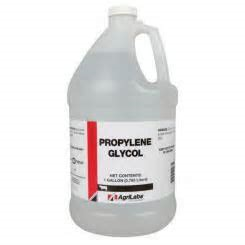Chemical of the Week- Propylene Glycol (Pro-py-lene Gly-col)
- CPK Shea-Kourtney

- Jan 16, 2018
- 3 min read
Updated: Jul 26, 2018
Chemical of the Week- Can you find this chemical in your medicine, food or skin care product in your home?
What is it?
A colorless, petroleum based, creamy liquid with a faintly sweet taste commonly found in anti-freeze (a de-icing agent), paint, theatrical fog, plastics and more. It's an alcohol produced by fermentation of yeast and carbohydrates. This gives it the designation of "carbohydrate" when used in foods.
What else is propylene glycol commonly found in?
Propylene Glycol or PG is also found in thousands of processed foods such as Dunkin Donuts flavored ice tea, pet food, medications like valium, Xanax, Lorazapam, to help your body absorb chemicals more efficiently, E-cigarettes, cosmetics, perfumes, Windex, deodorants, Glade aerosol, lotions, body wash, shampoos, mascara, Clearasil, anti-bacterial soaps, Noxzema, Tooth paste, Pet shampoo, the list, I'm afraid, goes on and on.
This chemical seems to be in just about everything, what makes it so harmful?
Well...It's complicated. Propylene glycol is the third “product” in a chemical process beginning with propene, which is a byproduct of fossil fuels and PG is found in nature as a byproduct of fermentation. Propene once converted to propylene oxide, a volatile compound frequently used in creating polyurethane plastics (a probable carcinogen), is hydrolyzed by separation of molecules simply by adding water, and waa-laa, you get propylene glycol. (In layman's terms- you get "supposed" good by adding H2O to bad)
Numerous studies have shown propylene glycol, when in vapor form, can cause irritation of the mucous membranes in the respiratory tract and irritation of the eyes. E-cigarette's vapor, propylene glycol, is responsible for contributing to taste and smoothness of the smoke.
In infants and pregnant women, PG enters the body as an alcohol which is then metabolized in our body's pathways. These pathways in infants aren't mature until around 12-30 months of age. Pregnant women, infants, and those with kidney failure are unable to eliminate PG from the body. Inability to eliminate causes potential adverse reactions to liver, kidneys, neurological symptoms and more.
As a food additive, you should not exceed more than 25 mg of weight in 24 hours. (How do you even calculate that??)
PG is commonly added to your pets food. FDA states dogs can handle PG in small doses but can be toxic at certain levels which are unspecified. The bigger issue is with PG in cat food. Just a small amount can cause hemolytic anemia where the red blood cells are destroyed in cats. This is why cats die when they ingest anti-freeze.
Although banned from cat food, PG still shows up. A major reason why cat food gets recalled.
I don't have animals, kidney issues, nor am I pregnant. Should I still be worried?
Propylene Glycol isn't a dooms day chemical, and once again, you won't die from using it here and there. Prolonged use along with hundreds of other chemicals lurking in your medicines, foods and skin care products might build over time causing issues to present themselves in the long run.
Being aware so you can make an informed decision about what chemicals you'd want to subject you, your pets and family is what it's all about. Knowledge is power after all.
Propylene Glycol or PG is also found in thousands of processed foods such as Dunkin Donuts flavored ice tea, pet food, medications like valium, Xanax, Lorazepam, to help your body absorb chemicals more efficiently, E-cigarettes, cosmetics, perfumes, Windex, deodorants, Glade aerosol, lotions, body wash, shampoos, mascara, Clearasil, anti-bacterial soaps, Noxzema, Tooth paste, Pet shampoo, the list, I'm afraid, goes on and on.






Comments